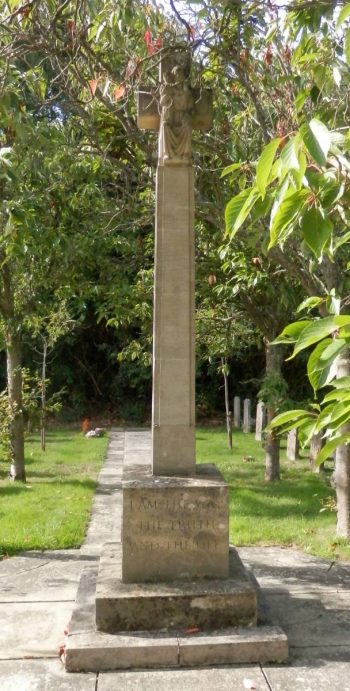Trinity Sunday, 24th May, 1964
“Nine hundred years ago, when our forbears built the little church at Penn to the glory of God, the bishop of that day must have come riding on horseback along the quiet grassy tracks one Trinity Sunday to take part in the Consecration Service.
In 1964, the Bishop travels by car along the busy roads of his diocese, whose population probably approaches in numbers that of the whole of England in those far-off days. However changed the times may be, I do not suppose that, in his golden robes and mitre, our Bishop looked so very different to his predecessor as he walked up the aisle of Holy Trinity Church, Penn, upon this very special day in its history.
 The church itself, this Trinity Sunday, was beautiful with white flowers and splendidly full, with a congregation whose ages varied from eighty to three years old, who were all to be witnesses to the Dedication by the Bishop of the new Churchyard Cross. The voices and the organ rose to the roof with resounding fervour, the singing quite filling the ancient building, and the words of the prayers dropped quietly into the silences between. The Bishop’s address was simple, sincere, even loving. (It was William Temple who, as Bishop, told parish priests “You must love your people into holiness.”) He explained much that lies behind the traditions of Christian burial and stressed that the body, one of God’s many gifts to man, must be treated with reverence, even when its period of usefulness is over.
The church itself, this Trinity Sunday, was beautiful with white flowers and splendidly full, with a congregation whose ages varied from eighty to three years old, who were all to be witnesses to the Dedication by the Bishop of the new Churchyard Cross. The voices and the organ rose to the roof with resounding fervour, the singing quite filling the ancient building, and the words of the prayers dropped quietly into the silences between. The Bishop’s address was simple, sincere, even loving. (It was William Temple who, as Bishop, told parish priests “You must love your people into holiness.”) He explained much that lies behind the traditions of Christian burial and stressed that the body, one of God’s many gifts to man, must be treated with reverence, even when its period of usefulness is over.
The recessional hymn took us all out into the churchyard. We went through the doorway marked “Jesus said, I am the Door” into the Churchyard extension beyond. Here, in this old walled garden already dotted with recent headstones bearing the names of our own dear friends, stood the Cross. Just as Sir Edward Maufe had designed and pictured it, so had Mr. Darsie Rawlins turned drawings into stone, and together they have given us this beautiful conception of Comfort from the Cross; for where we might expect to find the crucified Christ, we find instead the lovely figures of Mother and Child.
In a humble part of its history, this land had. been part of the Vicar’s glebe – his vegetable garden-and earlier still we find it described as a vineyard, perhaps to provide grapes for the Communion wine in the days when all communities had to be self-supporting. Twelve years ago, when this ground was consecrated because the churchyard was found to be full, there was born the germ of an idea for following mediaeval practice by having one central cross.. standing in benediction over all the graves.
The congregation stood grouped round this central cross, the centre of this churchyard, the centre of this service, and also at the centre of the new cruciform stone-flagged pathways, designed to be seen as a cross from the air. (What, I wonder, would our equestrian bishop of long ago thought of this fine gesture to the present age?) The Service of Dedication continued as Mr. Stanley Holloway read a beautifully appropriate piece from “Pilgrim’s Progress” ” … just as Christian came up with the cross, his burden loosed from off his shoulders and fell from his back … it was very surprising to him that the sight of the cross should thus ease him of his burden … ‘.
Then came the moment of dedication when the Lord Bishop said, “In the faith of Jesus Christ we dedicate this Churchyard Cross to the Glory of God … ”
We had done what we could to give beauty and comfort in death and, when the service was over, we came away through the green countryside with a strong sense of the past and yet a great hope for the future that we may be given the strength to devote ourselves while we may to the tremendous task of living our lives to the Glory of God.”
Parish Newsletter, June 1964, B.S. (Probably Barbara Saunders)
Footnote: Parish Newsletter March 1964: Oscar Muspratt writes:
“After several years preparation, we launched the special appeal for Sir Edward Maufe’s scheme for the permanent layout of the walled garden now being used as our churchyard. The most generous gift of £500 by Mr W.Q. Henriques was followed by…..As the year ended we had passed the £2,000 mark and now need only several hundred pounds to complete the scheme for Trinity Sunday 1964 when the Bishop of Oxford will take the dedication service. The actual work is well in hand.”
Wilfred Quixano Henriques, OBE, gave his ‘generous gift’ of £500 in 1963, and sadly his wife Victoria died in the Spring of 1964, around the time that the cross was consecrated on Trinity Sunday, 24th May. Wilfred died 04/1975 and is buried with his wife in plot 64, a few yards from the central cross.
